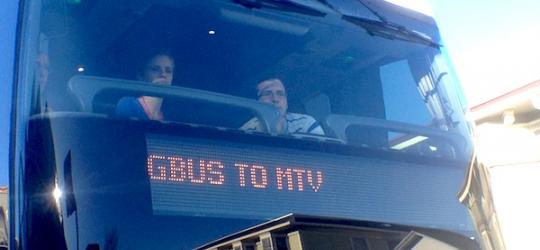The vaunted Google Bus pilot program is now in legal limbo as local activists appeal the deal to regulate the shiny behomoths, on environmental grounds. As we wait and see what the next step will be, one technology journalist decided to figure out for himself what the SFMTA says the pilot program aims to do: track the number of tech buses running around San Francisco.
Well, to be fair, Kevin Poulsen, investigations editor at Wired magazine, only tracked the buses flying by his home. But the process doesn’t seem too tough to replicate.
As he writes in his Wired post:
“Last week, it occurred to me that I might start monitoring the local Wi-Fi environment to determine how often the Apple Bus really comes by. My wife guessed 10 times a day. I’d have said 20.”
So essentially, he used the Apple bus’ Wi-Fi, provided for their employees, to track movements of the bus. He didn’t make any bets on it, but if he had, it seems his wife would’ve lost.
“After a week of reverse-wardriving, it appears the Apple Bus passes my house an average of 36 times a day, and is uncannily punctual, especially in the a.m., when the first bus reliably pops up on my Wi-Fi radar between 6:23:33 and 6:23:56 every morning.
The second bus passes four or five minutes later, the third 25-minutes after that, another at 6:58, give or take a minute. By 10 a.m. as many as 15 more Apple buses have passed. After that they become infrequent, and die out entirely a few minutes after 2:00 p.m., before they return in force at 5:00 p.m. — presumably taking Apple workers home. The last bus registers at about 10:15 at night.”

The wifi trail shows how many times particular tech buses drove by this Wired journalist’s house.
Why care about tracking them in the first place? It’s about the impact of livability in the surrounding area, an idea that so far hasn’t been factored in to the $1 per stop, per day argument made by Mayor Ed Lee and the city. Poulsen writes:
These buses are huge, intimidating, Greyhound-sized affairs, many of them double-deckers, that feel outsized on a relatively quiet street of single-family homes. I haven’t stockpiled much umbrage over them, but some of my neighbors who’ve lived here longer hate the buses. There’s something disconcerting about having your street turn into a major artery in the transportation infrastructure of a company 45 miles away, without so much as a mailer (“Hi! We’re Apple. We’ll be using your street for a while.”).
When the outrage over the $1 per stop, per day number spiked recently, a Google spokesperson said in a release, “San Francisco residents are rightly frustrated that we don’t pay more to use city bus stops. So we’ll continue to work with The City on these fees, and in the meantime will fund Muni passes for low-income students for the next two years.”
Until the SFMTA figures out ways to mitigate the impact of these buses, let’s hope more tech-inclined people track their impacts on the city. You can see the original Wired story here.

